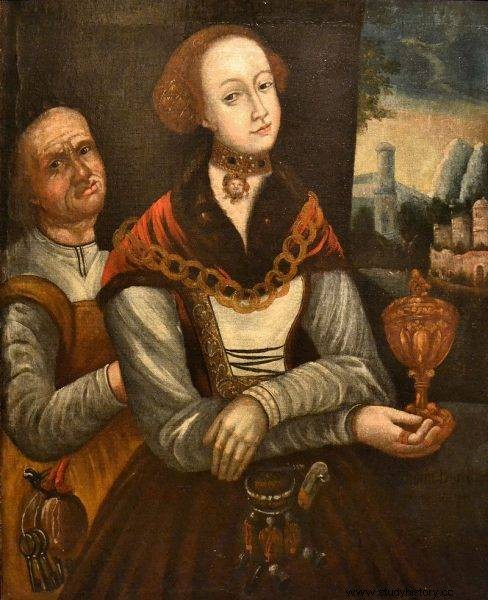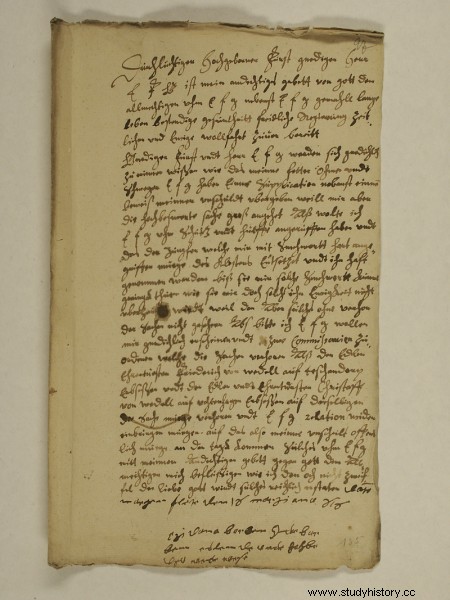A romantic legend says that the curse she casts was to lead to the annihilation of a powerful family. An unhappy love started her wandering in life and led her to the stake. Who was Sydonia von Borck? A powerful witch? Or maybe a woman wronged by fate?
“You see in front of you an old woman deceived by her neighbors and relatives and accused by them of heavenly power. I even lacked the human power to deal with the injustices of my relatives for the property of those who had to stand "- this is the form of Sydonia von Borcke's words from her witch trial as quoted by Bogdan Frankiewicz in his book" Sydonia ".
They were the result of many wrongs and great suffering that she experienced in her life. This is her path to the pile.
Beauty from Pomerania
She was born around 1548 in Strzmielach, although the exact date of her birth is unknown. She was the daughter of Count Otto Borck and Anna von Schwiecheld. Pampered by her loved ones, she grew into an extremely beautiful young woman endowed with many talents. As we read in the latest book by Sławomir Kopra, “Jagiellons. Golden Age ":
It is not known what the fate of Sydonia and Gryfit would have turned out if, as a young girl, she had not found herself at the court of Prince Philip I in Wołogoszcz (Wolgast). It was there that she met her peer, son of Prince Philip, Ernest Ludwik.

A double portrait of Sydonia von Borck as a young and old woman
The beautiful noblewoman and the young prince fell in love with each other. Sydonia quickly fell into the trap of sweet words and false promises of a common future. She completely ignored the other suitors - including the famous painter Lucas Cranach the Younger.
However, as is the case most often in such stories, Prince Ernest Ludwik - though sincere in his intentions - ultimately did not commit a mesalliance. At the instigation of his family, in 1577 he married Zofia Jadwiga - the daughter of the Duke of Brunswick. Sławomir Koper recalls that:
offended Sydonia immediately left the Wallachian manor, and when Ernest married the Brunswick princess, she and her family were to curse him. Apparently she stated that "it will not be 50 years and the Griffin family will perish" . If it was true, then she was not very much wrong ...
Hard life of a noblewoman
After leaving the castle, Sydonia went to the care of her brother, her father died in 1568. Together with his sister Dorota, they found themselves under the wing of Ulrich, who was not too eager to share the property he had inherited from his ancestors. He ordered the sisters to relinquish their property rights, promising support and pensions in return.
A year later, Ulrich got married, and the growing conflict between the sisters-in-law prompted Sydonia and Dorota to leave. This is how their wandering began, which we can trace through the files of court cases. Sydonia had to claim her property rights and pensions for the rest of her life because her brother did not fulfill any obligations.

The text was created, among others based on the latest book by Sławomir Kopra “Jagiellonowie. The Golden Age ”, which has just been released by Bellona.
In 1604 - at the request of relatives - she was placed in the convent in Marianów. It was known from the very first moments that this story could not end well. Getting out of the car after arriving at the convent, the woman broke her leg.
Due to her age, she was assigned the position of Deputy Superior. However, in the same year, this dignity was taken away from her due to the fact that she was not fulfilling her duties. These, in turn, she did not complete, because she was preoccupied with the ongoing processes, as well as new interests that were to lead her to the pile ...
Wicked Witch
Sydonia von Borck never married during her long life. Instead, she learned about herbs and their properties, and surrounded herself with animals. She had a dog that she liked very much, and which became the subject of a dispute with her ex-fiancé, Henryk Prechel. For Henry decided to take back the Sidonia animal - probably out of pure spite.
However, fate quickly took revenge on him for this act! Henry's child died shortly after these events, and Henry blamed Sidonia. In response to the accusations, the woman admitted that the child had been bitten by her dog, but insisted that she had nothing to do with it.
Since then, the animal has become a very important part of the Sidonia trials. All the more so because when asked about his role in her life, she immediately replied:"He predicted my death".
Way to the stake
On October 16, 1612, Sydonia von Borcke was officially accused of witchcraft by Anna von Apenburg from the Marianów monastery. Since then, the noose around her has started to tighten. As Sławomir Koper writes:
[Sidonia] was incapacitated and banned from leaving the monastery where she was staying. She decided to make an official complaint to Prince Philip and tried to get outside with the ax. She was forced to return to her cell, and the curses and threats were well remembered in the process that she did not spare her oppressors.
Eventually, she was imprisoned at the Oderburg castle in Grabów. She was kept in a cold, damp and dark cell. We read in court files that the woman did not plead guilty. Accordingly, the executioner was allowed to torture, which was to draw the appropriate testimony from the accused. During the monstrous executions, Sydonia lost her mind. Finally she was tied up, her legs placed in stocks and screwed together. After rereading the charges, she pleaded guilty to everything.

A letter from Sydonia von Borcke to the Duke of Szczecin, Philip II, in which she asks for a reconsideration of her complaints about her companions in the Marianów monastery.
When she recovered a little, she withdrew the testimony, which, however, only resulted in further torture and forced confirmation of the truthfulness of the accusations. Ultimately, she was convicted of the manslaughter of nine people. As a noblewoman, she had the right to be beheaded with a sword. The sentence was carried out on August 19, 1620 in Szczecin near the Mill Gate. Sydonia's body was burned at the stake and buried in the poor cemetery.
Sławomir Koper, describing Sidonia in his latest book “Jagiellonowie. Golden Age ”, he says:
Sydonia was the perfect victim. For years, was interested in herbalism and had suspicious contacts with women accused of witchcraft. Plus, she was quarrelsome and overbearing, she also often threatened her opponents who, by some strange coincidence, were quickly leaving this world. To make matters worse, there was also the case of the alleged curse on the ruling dynasty ...
Literature:
- Frankiewicz, "Sydonia", Szczecin 1986.
- Koper, "The Jagiellonians. The Golden Age ”, Warsaw 2021.
- Pałęga, Trials for witchcraft in West Pomerania in the 16th and 17th centuries, based on the files of the Archives of the Dukes of Szczecin and the Ducal Court of the Court , in:"Czary i czarownica na Pomorze", ed. A. Majewska, Stargard 2008, pp. 105–116.
